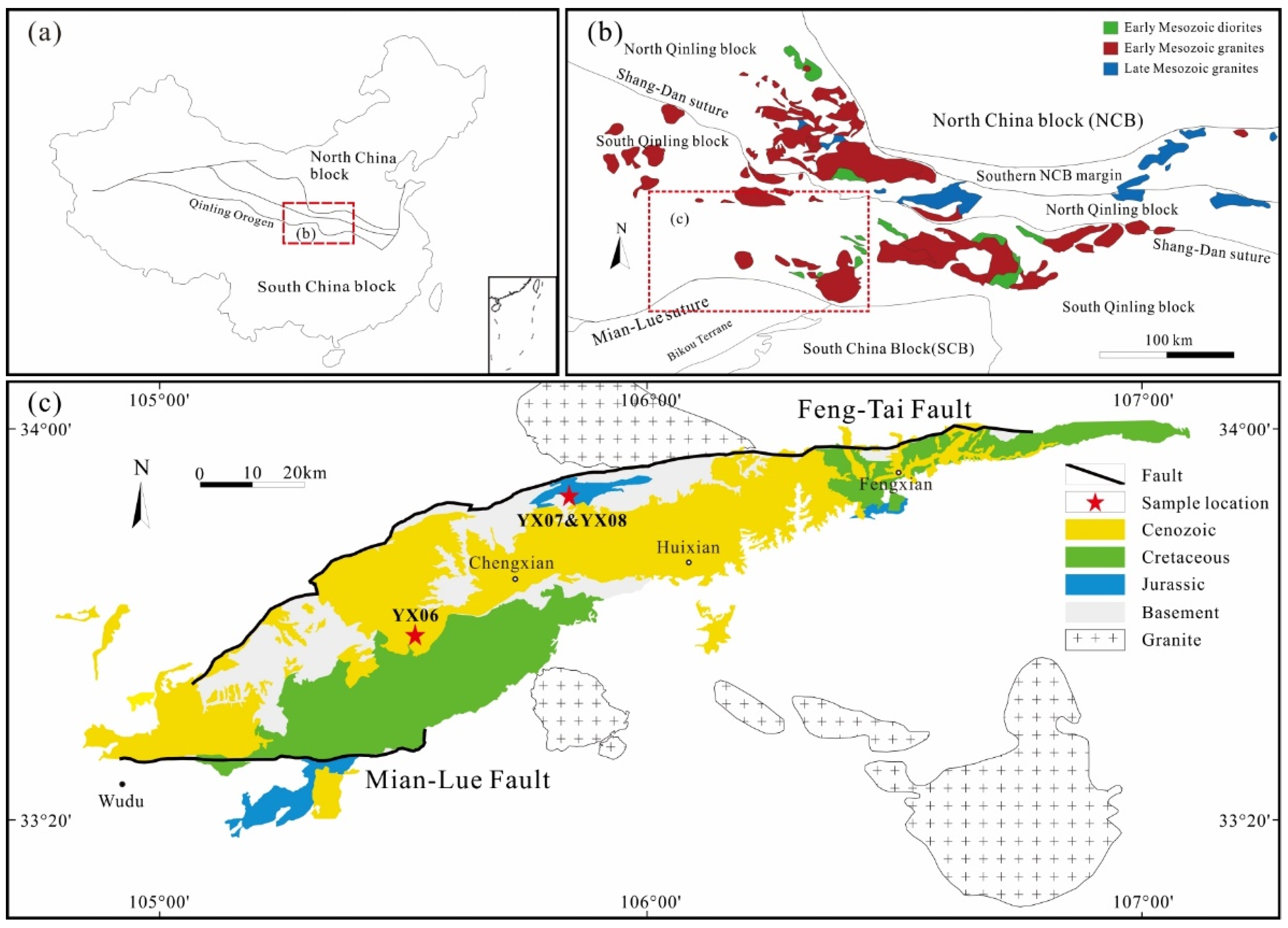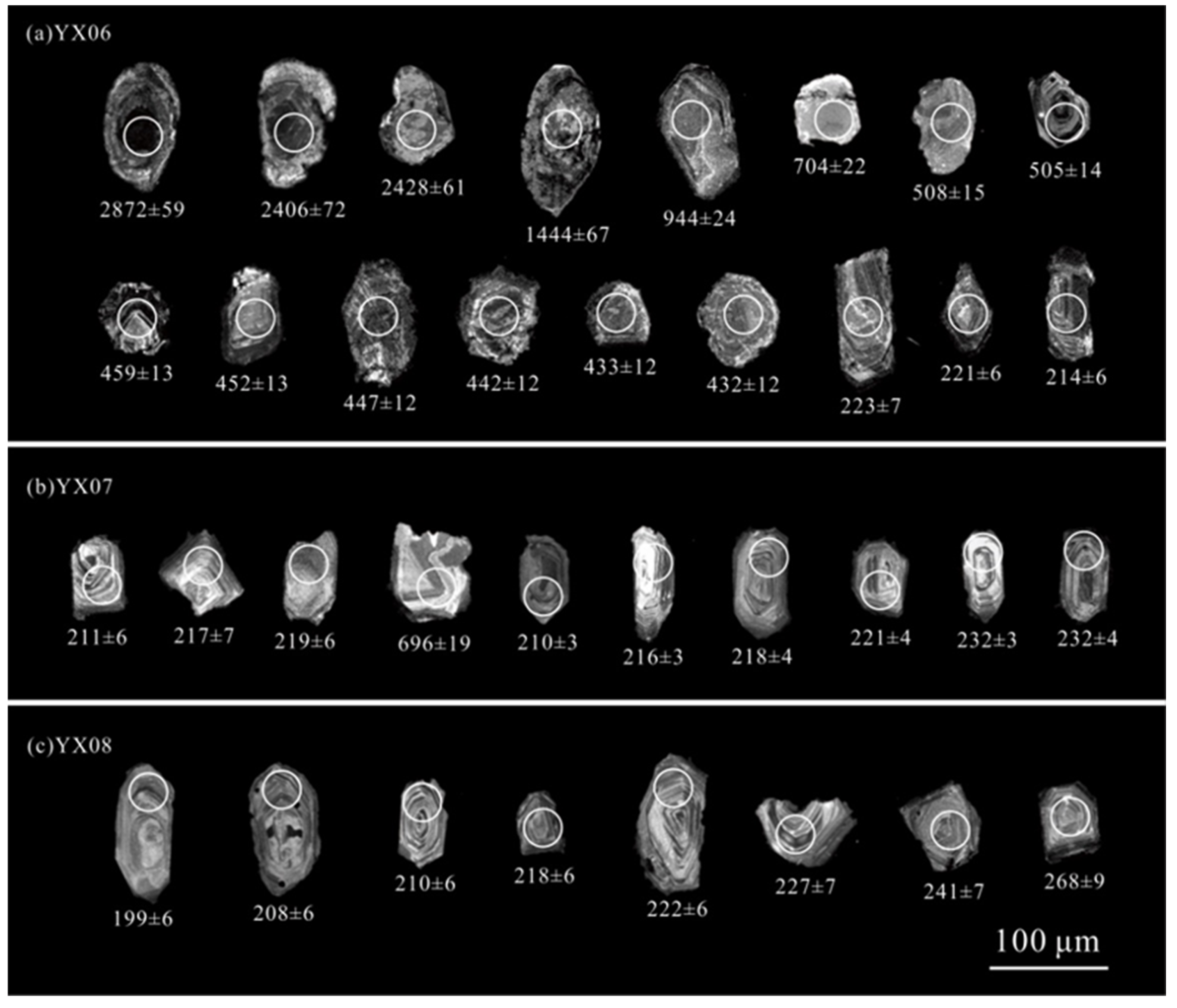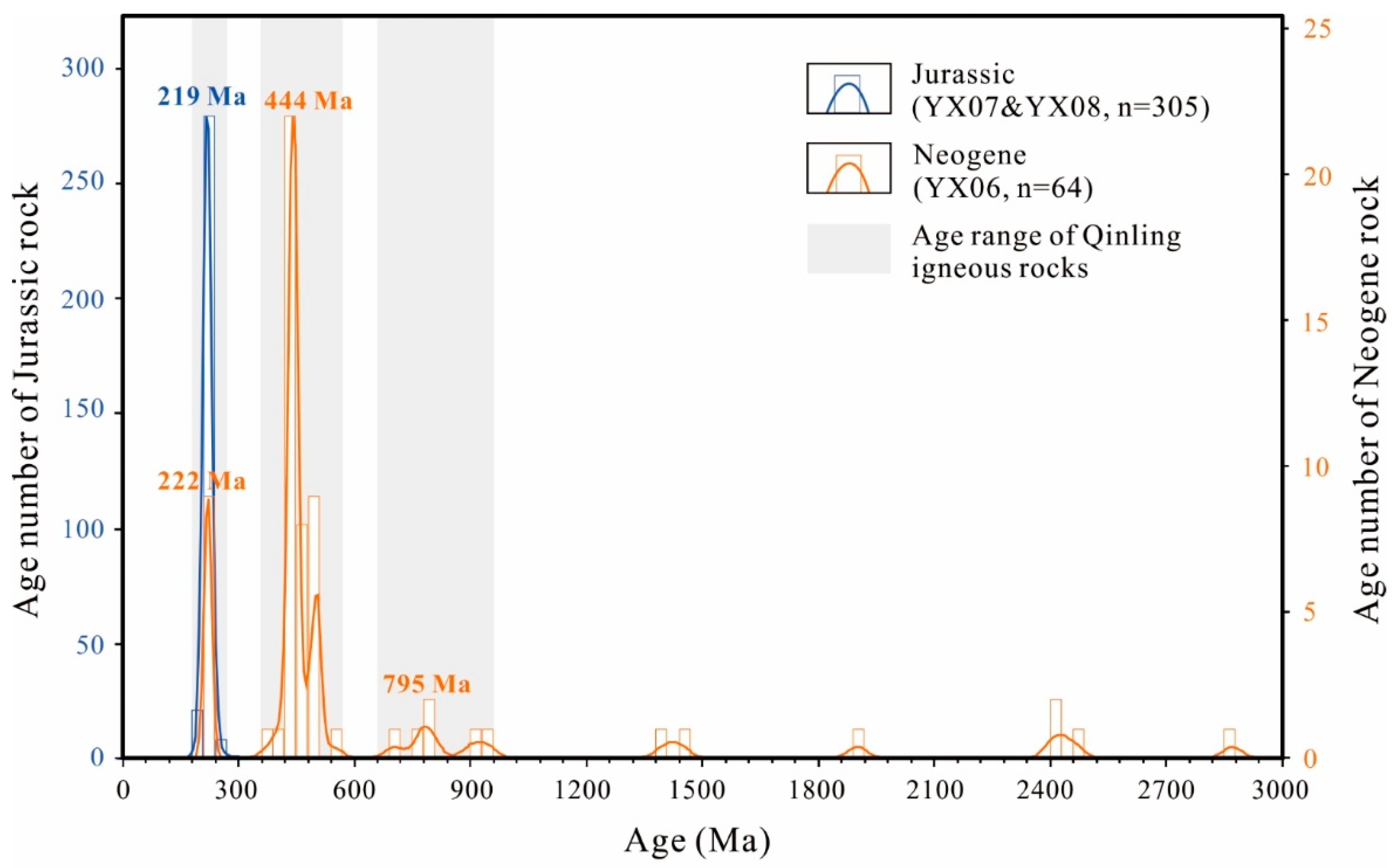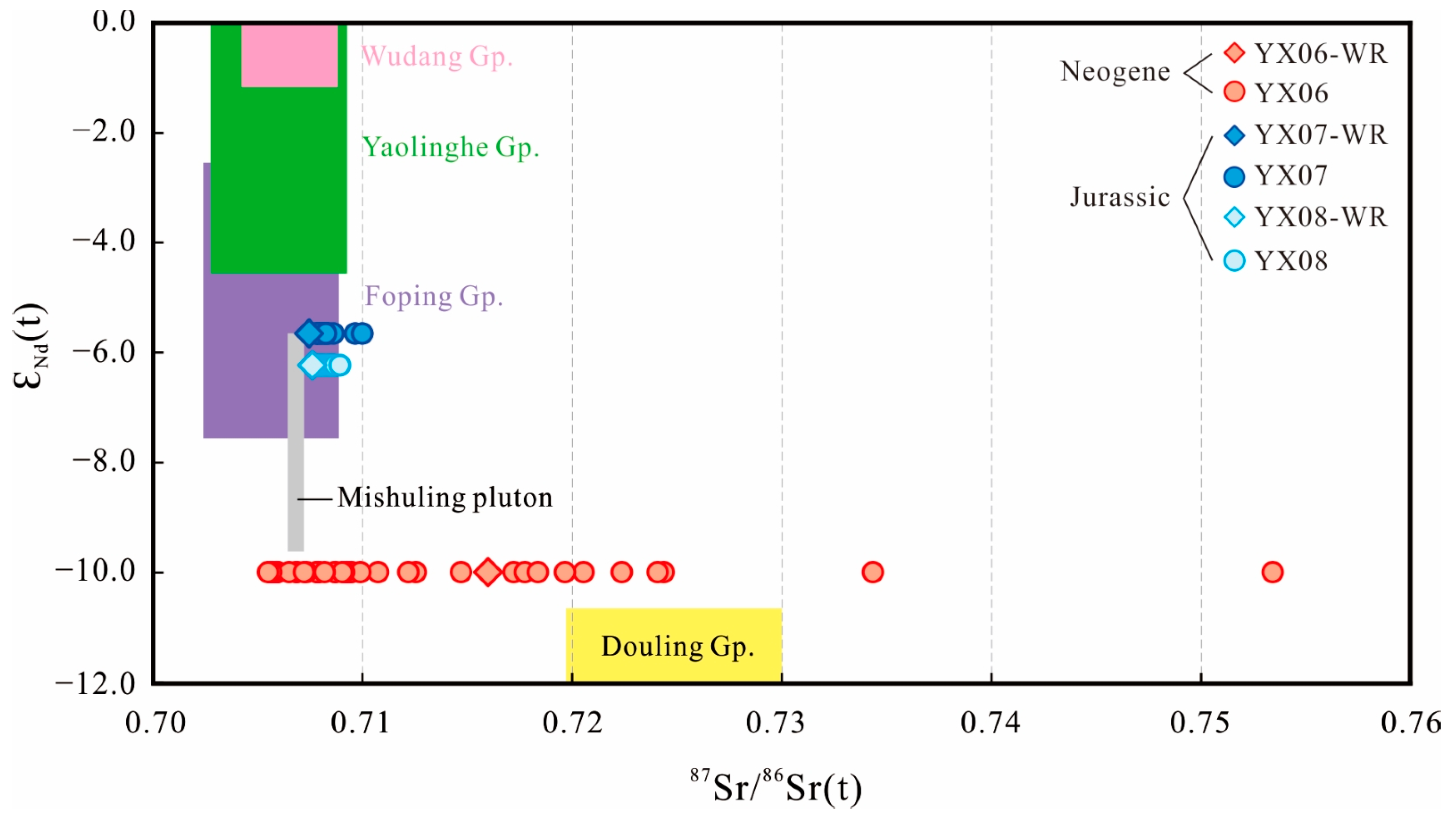Single-Grain Detrital Apatite Sr Isotopic Composition as an Indicator to Trace Sedimentary Sources: A Case Study of Sedimentary Rocks in the Hui-Cheng Basin, South Qinling, China
Abstract
:1. Introduction
2. Geological Setting and Samples

3. Analytical Techniques
4. Analytical Results
4.1. Detrital Zircon U-Pb Isotopic Ages
4.2. Whole-Rock Sr-Nd and Single-Grain Apatite Sr Isotopic Composition
4.3. Detrital Zircon Age Patterns and Changes in Sedimentary Sources
4.4. Detrital Apatite Sr Isotopic Composition for Tracing of Sedimentary Sources
5. Conclusions
Supplementary Materials
Author Contributions
Funding
Data Availability Statement
Acknowledgments
Conflicts of Interest
References
- Bhatia, M.R.; Crook, K.A.W. Trace element characteristics of graywackes and tectonic setting discrimination of sedimentary basins. Contrib. Mineral. Petrol. 1986, 92, 181–193. [Google Scholar] [CrossRef]
- Murphy, B.P.; Johnson, J.P.L.; Gasparini, N.M.; Sklar, L.S. Chemical weathering as a mechanism for the climatic control of bedrock river incision. Nature 2016, 532, 223–227. [Google Scholar] [CrossRef] [PubMed]
- Cawood, P.A.; Hawkesworth, C.L.; Dhuime, B. Detrital zircon record and tectonic setting. Geology 2012, 40, 875–878. [Google Scholar] [CrossRef] [Green Version]
- Gehrels, G.; Johnsson, M.J.; Howell, D.G. Detrital zircon geochronology of the Adams argillite and Nation River Formation, East-Central Alaska, USA. J. Sediment. Res. 1999, 69, 135–144. [Google Scholar] [CrossRef]
- He, S.; Cheng, H.; Li, S.Q.; Cao, C.; He, J.; Chen, F. Spatio-temporal evolution of the crustal uplift in eastern NE China: Constraint from detrital zircon ages of Late Mesozoic clastic rocks in the Boli Basin. Minerals 2022, 12, 1166. [Google Scholar] [CrossRef]
- Valverde, V.P.; Dörr, W.; Belka, Z.; Franke, W.; Wiszniewska, J.; Schastok, J. U-Pb single-grain dating of detrital zircon in the Cambrian of central Poland; implications for Gondwana versus Baltica provenance studies. Earth Planet. Sci. Lett. 2000, 184, 225–240. [Google Scholar] [CrossRef]
- Sircombe, K.N. Tracing provenance through the isotope ages of littoral and sedimentary detrital zircon, eastern Australia. Sediment. Geol. 1999, 124, 47–67. [Google Scholar] [CrossRef]
- Nelson, D.R. An assessment of the determination of depositional ages for Precambrian clastic sedimentary rocks by U-Pb dating of detrital zircons. Sediment. Geol. 2001, 141–142, 37–60. [Google Scholar] [CrossRef]
- Chen, F.; Zhu, X.Y.; Wang, W.; Wang, F.; Hieu, P.T.; Siebel, W. Single-grain detrital muscovite Rb-Sr isotopic composition as an indicator of provenance for the Carboniferous sedimentary rocks in northern Dabie, China. Geochem. J. 2009, 43, 257–273. [Google Scholar] [CrossRef] [Green Version]
- Chen, F.; Siebel, W.; Satir, M.; Terzioğlu, M.; Saka, K. Geochronology of the Karadere basement (NW Turkey) and implications for the geological evolution of the Istanbul zone. Int. J. Earth Sci. 2002, 91, 469–481. [Google Scholar] [CrossRef]
- Spiegel, C.; Kulemann, J.; Frisch, W. Tracing sediment pathways by zircon fission track analysis: Oligocene marine connections in Central Europe. Int. J. Earth Sci. 2007, 96, 363–374. [Google Scholar] [CrossRef]
- Oliver, G.J.H.; Chen, F.; Buchwald, R.; Hegner, E. Tracking fast tectometamorphism in the Scottish Grampian Buchan and Barrovian zones. Geology 2000, 28, 459–462. [Google Scholar] [CrossRef]
- Wu, G.H.; Zhang, H.; Hu, A.M.; Li, W.Y.; Huang, X.G.; Cheng, H.; He, J.; Chen, F. Provenance of the early Paleozoic sedimentary succession in the Lancang Block, SW China: Implications for the tectonic evolution of the northern margin of Gondwana. J. Asian Earth Sci. 2022, 231, 105229. [Google Scholar] [CrossRef]
- Moecher, D.P.; Badenszki, E.; Daly, J.S.; Chew, D. Beyond zircon: Incorporating detrital feldspar Pb isotope analysis into the multi-proxy toolbox for sedimentary provenance analysis—An example from a long-lived Eastern Laurentian Clastic System. J. Geol. 2023; in press. [Google Scholar]
- Wu, Q.S.; Xu, J.Z.; Lin, T.G.; Xu, X.G. Study of strontium isotopic geochemical characteristics of apatite and their applications. Sci. Sin. Ser. B 1983, 26, 1109–1120. [Google Scholar]
- Wolf, M.B.; London, D. Incongruent dissolution of REE- and Sr-rich apatite in peralumineous granite liquids: Differential apatite, monazite and xenotime solubilities during anatexis. Am. Mineral. 1995, 80, 765–775. [Google Scholar] [CrossRef]
- Chen, F.; Hegner, E.; Todt, W. Zircon ages and Nd isotopic and chemical compositions of orthogneisses from the Black Forest, Germany: Evidence for a Cambrian magmatic arc. Int. J. Earth Sci. 2000, 88, 791–802. [Google Scholar] [CrossRef]
- Li, Q.L.; Chen, F.; Wang, X.L.; Li, X.H.; Li, C.F. Ultra-low procedural blank and the single-grain mica Rb-Sr isochron dating. Chin. Sci. Bull. 2005, 50, 2861–2865. [Google Scholar]
- Zhang, G.W.; Zhang, B.R.; Yuan, X.C.; Xiao, Q.H. Qinling Orogenic Belt and Continental Dynamics; Science Press: Beijing, China, 2001; 805p. (In Chinese) [Google Scholar]
- Dong, Y.P.; Zhang, G.W.; Neubauer, F.; Liu, X.M.; Genser, J.; Hauzenberger, C. Tectonic evolution of the Qinling orogen, China: Review and synthesis. J. Asian Earth Sci. 2011, 41, 213–237. [Google Scholar] [CrossRef]
- Wang, H.; Xu, X.; Chen, J.; Yan, Z.; Li, T.; Zhu, T. Constraints from zircon U-Pb chronology of Yudongzi Group magnetite-quartzite in the Lueyang area, Southern Qinling, China. Acta Geol. Sin. 2011, 85, 1284–1290. [Google Scholar]
- Hu, J.; Liu, X.; Chen, L.; Qu, W.; Li, H.; Geng, J. A ~2.5 Ga magmatic event at the northern margin of the Yangtze craton: Evidence from U-Pb dating and Hf isotope analysis of zircons from the Douling Complex in the South Qinling orogen. Chin. Sci. Bull. 2013, 58, 3564–3579. [Google Scholar] [CrossRef] [Green Version]
- Nie, H.; Yao, J.; Wan, X.; Zhu, X.Y.; Siebel, W.; Chen, F. Precambrian tectonothermal evolution of South Qinling and its affinity to the Yangtze Block: Evidence from zircon ages and Hf-Nd isotopic compositions of basement rocks. Precambrian Res. 2016, 286, 167–179. [Google Scholar] [CrossRef]
- Ling, W.; Ren, B.; Duan, R.; Liu, X.; Mao, X.; Peng, L.; Liu, Z.; Cheng, J.; Yang, H. Zircon U-Pb isotopic ages and geological implication of mafic rocks of the Wudang and Yaolinghe Groups in southern Qinling. Chin. Sci. Bull. 2007, 52, 1445–1456. [Google Scholar]
- Zhu, X.; Chen, F.; Nie, H.; Siebel, W.; Yang, Y.; Xue, Y.; Zhai, M. Neoproterozoic tectonic evolution of South Qinling, China: Evidence from zircon ages and geochemistry of the Yaolinghe volcanic rocks. Precambrian Res. 2014, 245, 115–130. [Google Scholar] [CrossRef]
- Hu, F.; Liu, S.; Ducea, M.N.; Zhang, W.; Deng, Z. The geochemical evolution of the granitoid rocks in the South Qinling Belt: Insights from the Dongjiangkou and Zhashui intrusions, central China. Lithos 2017, 278–281, 195–214. [Google Scholar] [CrossRef]
- Qin, J.-F.; Lai, S.-C.; Li, Y.-F. Multi-stage granitic magmatism during exhumation of subducted continental lithosphere: Evidence from the Wulong pluton, South Qinling. Gondwana Res. 2013, 24, 1108–1126. [Google Scholar] [CrossRef]
- Dong, Y.P.; Santosh, M. Tectonic architecture and multiple orogeny of the Qinling Orogenic Belt, Central China. Gondwana Res. 2016, 29, 1–40. [Google Scholar] [CrossRef]
- Zhang, Y.Q.; Liao, C.Z.; Shi, W.; Hu, B. Neotectonic evolution of the peripheral zones of the Ordos basin and geodynamic setting. Geol. J. China Univ. 2006, 12, 285–297, (In Chinese with English abstract). [Google Scholar]
- Guo, J.J.; Han, W.F.; Li, X.F. The cenozoic tectonic evolution of the west Qinling: Constraints on the uplift and deformation of the Qinghai-Tibet Plateau. Earth Sci. Front. 2009, 16, 215–225, (In Chinese with English abstract). [Google Scholar] [CrossRef]
- Li, W.; Dong, Y.P.; Guo, A.L.; Liu, X.M.; Liu, Y.Q.; Zha, X.F.; Zhang, K.L. Sedimentary fill history of the Huicheng Basin in the West Qinling Mountains and associated constraints on Mesozoic intracontinental tectonic evolution. Sci. China Earth Sci. 2013, 43, 730–744. [Google Scholar] [CrossRef]
- Liu, S.F.; Li, W.P.; Wang, K.; Qian, T.; Jiang, C.X. Late Mesozoic development of the southern Qinling-Dabieshan foreland fold-thrust belt, Central China, and its role in continent-continent collision. Tectonophysics 2015, 644–645, 220–234. [Google Scholar] [CrossRef]
- Zhang, Y.P. Mesozoic Range-Basin Coupling and Tectonic Evolution of the Mid-Segment of the Central China Orogen. Ph.D. Thesis, Chinese Academy of Geological Sciences, Beijing, China, 2018; 194p. (In Chinese with English abstract). [Google Scholar]
- Liu, J.H.; Zhang, P.Z.; Lease, R.O.; Zheng, D.W.; Wan, J.L.; Wang, W.T.; Zhang, H.P. Eocene onset and late Miocene acceleration of Cenozoic intracontinental extension in the North Qinling range-Weihe graben: Insights from apatite fission track thermochronology. Tectonophysics 2013, 584, 281–296. [Google Scholar] [CrossRef]
- Heberer, B.; Anzenbacher, T.; Neubauer, F.; Genser, J.; Dong, Y.P.; Dunkl, I. Polyphase exhumation in the western Qinling Mountains, China: Rapid Early Cretaceous cooling along a lithospheric-scale tear fault and pulsed Cenozoic uplift. Tectonophysics 2014, 617, 31–43. [Google Scholar] [CrossRef] [PubMed] [Green Version]
- Zhang, Y.L.; Wang, Z.Q.; Wang, G.; Wang, K.M. Detrital zircon geochronology of the Late Paleozoic Taohekou Formation and its constraints on the Paleozoic magmatic events in North Daba Mountains. Acta Geol. Sin. 2016, 90, 728–738. [Google Scholar]
- Liu, Y.S.; Hu, Z.Q.; Gao, S.; Günther, D.; Xu, J.; Gao, C.G.; Chen, H.H. In situ analysis of major and trace elements of anhydrous minerals by LA-ICP-MS without applying an internal standard. Chem. Geol. 2008, 257, 34–43. [Google Scholar] [CrossRef]
- Liu, Y.S.; Hu, Z.C.; Zong, K.Q.; Gao, C.G.; Chen, H.H. Reappraisement and refinement of zircon U-Pb isotope and trace element analyses by LA-ICP-MS. Chin. Sci. Bull. 2010, 55, 1535–1546. [Google Scholar] [CrossRef]
- Li, W.Y.; Qi, Z.Q.; He, J.F.; Zhao, J.X.; Wang, Z.Y.; Xiao, P.; He, J. A preparation method of the TaF5 emitter solution with high ionization efficiency and low Sr blank for the Sr isotopic measurement of micro-samples. J. Earth Sci. Environ. 2023, 45, 256–265, (In Chinese with English abstract). [Google Scholar]
- Zhu, L.M.; Zhang, G.W.; Yang, T.; Wang, F.; Gong, H.J. Geochronology, petrogenesis and tectonic implications of the Zhongchuan granitic pluton in the Western Qinling metallogenic belt, China. Geol. J. 2013, 48, 310–334. [Google Scholar] [CrossRef]
- Duan, M.; Niu, Y.L.; Kong, J.J.; Sun, P.; Hu, Y.; Zhang, Y.; Chen, S.; Li, J.Y. Zircon U-Pb geochronology, Sr-Nd-Hf isotopic composition and geological significance of the Late Triassic Baijiazhuang and Lvjing granitic plutons in West Qinling Orogen. Lithos 2016, 260, 443–456. [Google Scholar] [CrossRef] [Green Version]
- Xiong, X.; Zhu, L.M.; Zhang, G.W.; Li, B.; Qi, L.; Stevenson, D.; Yang, T.; Wang, F.; Zheng, J.; Jiang, H.; et al. Geology and geochemistry of the Triassic Wenquan Mo deposit and Mo-mineralized granite in the Western Qinling Orogen, China. Gondwana Res. 2016, 30, 159–178. [Google Scholar] [CrossRef]
- Kong, J.J.; Niu, Y.L.; Duan, M.; Zhang, Y.; Hu, Y.; Li, J.Y.; Chen, S. Petrogenesis of Luchuba and Wuchaba granitoids in western Qinling: Geochronological and geochemical evidence. Mineral. Petrol. 2017, 111, 887–908. [Google Scholar] [CrossRef] [Green Version]
- Kong, J.J.; Niu, Y.L.; Duan, M.; Shao, F.L.; Xiao, Y.Y.; Zhang, Y.; Guo, P.P.; Sun, P.; Gong, H.M. The syncollisional granitoid magmatism and crust growth during the West Qinling Orogeny, China: Insights from the Jiaochangba pluton. Geol. J. 2019, 54, 4014–4033. [Google Scholar] [CrossRef] [Green Version]
- Xue, Y.Y.; Siebel, W.; He, J.F.; Zhang, H.; Chen, F. Granitoid petrogenesis and tectonic implications of the Late Triassic Baoji pluton, North Qinling Orogen, China: Zircon U-Pb ages and geochemical and Sr-Nd-Pb-Hf isotopic compositions. J. Geol. 2018, 126, 119–139. [Google Scholar] [CrossRef] [Green Version]
- Zhang, Y.S.; Siebel, W.; He, S.; Wang, Y.; Chen, F. Origin and genesis of Late Jurassic to Early Cretaceous granites of the North Qinling Terrane, China. Lithos 2019, 336–337, 242–257. [Google Scholar] [CrossRef]
- Dou, J.Z.; Huang, X.G.; Chen, F. Successive magma mixing in deep-seated magma chambers recorded in zircon from mafic microgranular enclaves in the Triassic Mishuling granitic pluton, Western Qinling, Central China. J. Asian Earth Sci. 2021, 207, 104656. [Google Scholar] [CrossRef]
- Zhang, H.; Li, S.Q.; Fang, B.W.; He, J.F.; Xue, Y.Y.; Siebel, W.; Chen, F. Zircon U-Pb ages and geochemistry of migmatites and granites in the Foping dome: Evidence for Late Triassic crustal evolution in South Qinling, China. Lithos 2018, 296–299, 129–141. [Google Scholar] [CrossRef]
- Zhang, Y.L.; Wang, Z.Q. Provenance analysis of Early Cretaceous Huixian-Chengxian basin, western Qinling orogenic belt, China: Constraints from zircon U-Pb geochronology. Geol. Bull. China 2011, 30, 37–50, (In Chinese with English abstract). [Google Scholar]
- Zhang, H.; Wu, G.H.; Cheng, H.; Ye, R.S.; He, J.F.; Chen, F. Late Triassic high Mg diorites of the Wulong pluton in the South Qinling Belt, China: Petrogenesis and implications for crust-mantle interaction. Lithos 2019, 332–333, 135–146. [Google Scholar] [CrossRef]
- Wang, Y.; Zhang, Y.S.; Cheng, H.; Chen, F. Complex magma sources of late Mesozoic granites along the southern margin of the North China Craton: Constraints from geochemistry and geochronology of the massive Heyu and Lantian plutons. Int. Geol. Rev. 2020, 62, 1862–1882. [Google Scholar] [CrossRef]
- Jochum, K.P.; Stoll, B.; Weis, U. In situ Sr isotopic analysis of low Sr silicates using LA-ICP-MS. J. Anal. At. Spectrom. 2009, 24, 1237–1243. [Google Scholar] [CrossRef]
- Woodhead, J.; Swearer, S.; Hergt, J.; Maas, R. In situ Sr-isotope analysis of carbonates by LA-MC-ICP-MS: Interference corrections, high spatial resolution and an example from otolith studies. J. Anal. At. Spectrom. 2005, 20, 22–27. [Google Scholar] [CrossRef]
- Woodhead, J.; Hergt, J.; Meffre, S.; Large, R.R.; Danyushevsky, L.; Gilbert, S. In situ Pb-isotope analysis of pyrite by laser ablation (multi-collector and quadrupole) ICPMS. Chem. Geol. 2009, 262, 344–354. [Google Scholar] [CrossRef]
- Zhu, X.Y.; Chen, F.; Liu, B.X.; Zhang, H.; Zhai, M.G. Geochemistry and zircon ages of mafic dikes in the South Qinling, central China: Evidence for late Neoproterozoic continental rifting in the northern Yangtze block. Int. J. Earth Sci. 2015, 104, 27–44. [Google Scholar] [CrossRef]
- Zhu, X.Y.; Chen, F.; Wang, W.; Hieu, T.P.; Wang, F.; Zhang, F. Zircon U-Pb ages of volcanic and sedimentary rocks of the Wudang Group in the Qinling orogenic belt in western Henan. Acta Geosci. Sin. 2008, 29, 817–829. [Google Scholar]
- Zhang, H.; Ye, R.S.; Liu, B.X.; Wang, Y.; Zhang, Y.S.; Siebel, W.; Chen, F. Partial melting of the South Qinling orogenic crust, China: Evidence from Triassic migmatites and diorites of the Foping dome. Lithos 2016, 260, 44–57. [Google Scholar] [CrossRef] [Green Version]
- Shi, Y.; Yu, J.H.; Santosh, M. Tectonic evolution of the Qinling orogenic belt, Central China: New evidence from geochemical, zircon U–Pb geochronology and Hf isotopes. Precambrian Res. 2013, 231, 19–60. [Google Scholar] [CrossRef]



| Sample No. | Rock Type | Number of Analyzed Grains | Range of Th/U Value | Range of Zircon Age (Ma) | Age Peak of Zircon (Ma) |
|---|---|---|---|---|---|
| YX06 | Neogene conglomerate | 64 | 0.16–2.27 | 214–2872 | ~222; ~444; ~795 |
| YX07 | Jurassic conglomerate | 122 | 0.34–0.68 | 205–696 | 221 |
| YX08 | Jurassic conglomerate | 183 | 0.30–0.62 | 198–268 | 219 |
| Sample No. | Rb (ppm) | Sr (ppm) | 87Rb/86Sr | 87Sr/86Sr | 87Sr/86Sr (t) | Sm (ppm) | Nd (ppm) | 147Sm/144Nd | 143Nd/144Nd | εNd(t) | TMD (Ga) |
|---|---|---|---|---|---|---|---|---|---|---|---|
| YX06 | 60.4 | 106 | 1.650 | 0.716444 | 0.7160 | 2.71 | 13.0 | 0.1259 | 0.512117 | −10.0 | 1.79 |
| YX07 | 164 | 244 | 1.943 | 0.713542 | 0.7074 | 2.33 | 14.9 | 0.0946 | 0.512201 | −5.6 | 1.21 |
| YX08 | 130 | 217 | 1.734 | 0.712993 | 0.7076 | 1.42 | 7.55 | 0.1133 | 0.512200 | −6.2 | 1.44 |
| Grain No. | 87Sr/86Sr (Measured) | ±1σ | 85Rb/86Sr (Measured) | Grain No. | 87Sr/86Sr (Measured) | ±1σ | 85Rb/86Sr (Measured) | |
|---|---|---|---|---|---|---|---|---|
| YX06 | Neogene conglomerate | YX07 | Jurassic conglomerate | |||||
| 0716-21 | 0.71074 | 0.00006 | 0.00196 | 0715-01 | 0.70758 | 0.00003 | 0.00038 | |
| 0716-22 | 0.70923 | 0.00006 | 0.00204 | 0715-02 | 0.70779 | 0.00004 | 0.00422 | |
| 0716-23 | 0.70945 | 0.00004 | 0.00309 | 0715-03 | 0.70784 | 0.00004 | 0.00073 | |
| 0716-24 | 0.70685 | 0.00005 | 0.00023 | 0715-04 | 0.70838 | 0.00011 | 0.00198 | |
| 0716-25 | 0.72052 | 0.00005 | 0.00072 | 0715-05 | 0.70831 | 0.00005 | 0.00180 | |
| 0716-27 | 0.70558 | 0.00005 | 0.00029 | 0715-06 | 0.70800 | 0.00003 | 0.00092 | |
| 0716-28 | 0.72435 | 0.00004 | 0.00039 | 0715-07 | 0.70818 | 0.00005 | 0.00129 | |
| 0716-29 | 0.70988 | 0.00006 | 0.00088 | 0715-08 | 0.70808 | 0.00008 | 0.00123 | |
| 0716-30 | 0.75340 | 0.00018 | 0.00032 | 0715-09 | 0.70964 | 0.00003 | 0.00056 | |
| 0716-31 | 0.71468 | 0.00026 | 0.00029 | 0715-10 | 0.70795 | 0.00005 | 0.00093 | |
| 0716-32 | 0.71721 | 0.00003 | <0 | 0715-13 | 0.70781 | 0.00003 | 0.00198 | |
| 0716-33 | 0.70789 | 0.00032 | 0.00004 | 0715-14 | 0.70859 | 0.00005 | 0.00384 | |
| 0716-34 | 0.70593 | 0.00001 | <0 | 0715-17 | 0.70823 | 0.00005 | 0.00866 | |
| 0716-35 | 0.72235 | 0.00038 | <0 | 0715-20 | 0.70998 | 0.00022 | 0.00309 | |
| 0716-36 | 0.71253 | 0.00001 | 0.00000 | |||||
| 0716-37 | 0.70585 | 0.00004 | 0.00122 | YX08 | Jurassic conglomerate | |||
| 0716-38 | 0.70567 | 0.00013 | 0.00047 | 2140 | 0.70769 | 0.00005 | 0.00026 | |
| 0716-40 | 0.70910 | 0.00007 | 0.00040 | 2136 | 0.70771 | 0.00017 | 0.00164 | |
| 2001-2 | 0.70781 | 0.00003 | 0.00205 | 2126 | 0.70776 | 0.00004 | 0.00501 | |
| 2002-2 | 0.70648 | 0.00003 | 0.00503 | 2135 | 0.70778 | 0.00011 | <0 | |
| 2003-2 | 0.71774 | 0.00007 | 0.00240 | 2137 | 0.70788 | 0.00007 | 0.00073 | |
| 2004-2 | 0.70564 | 0.00003 | 0.00081 | 2123 | 0.70799 | 0.00021 | 0.00499 | |
| 2005 | 0.71965 | 0.00008 | 0.00228 | 2121-2 | 0.70799 | 0.00011 | 0.00219 | |
| 2006 | 0.70547 | 0.00003 | 0.00558 | 2139 | 0.70805 | 0.00009 | 0.00021 | |
| 2007 | 0.70869 | 0.00010 | 0.00123 | 2138 | 0.70815 | 0.00006 | 0.00054 | |
| 2008 | 0.72406 | 0.00005 | 0.00295 | 2122 | 0.70822 | 0.00011 | 0.00093 | |
| 2009 | 0.70731 | 0.00005 | 0.00049 | 2124 | 0.70840 | 0.00002 | 0.00037 | |
| 2010 | 0.70902 | 0.00007 | 0.00074 | 2134-2 | 0.70841 | 0.00010 | 0.00216 | |
| 2011 | 0.73433 | 0.00009 | 0.00131 | 2125 | 0.70851 | 0.00013 | 0.00446 | |
| 2012-2 | 0.70719 | 0.00008 | 0.00112 | 2127 | 0.70862 | 0.00020 | 0.00741 | |
| 2014 | 0.71835 | 0.00010 | 0.00129 | 2129 | 0.70866 | 0.00025 | 0.00091 | |
| 2015 | 0.71216 | 0.00011 | 0.00193 | 2128 | 0.70891 | 0.00026 | 0.00314 | |
| 2016 | 0.70817 | 0.00002 | 0.00089 | |||||
Disclaimer/Publisher’s Note: The statements, opinions and data contained in all publications are solely those of the individual author(s) and contributor(s) and not of MDPI and/or the editor(s). MDPI and/or the editor(s) disclaim responsibility for any injury to people or property resulting from any ideas, methods, instructions or products referred to in the content. |
© 2023 by the authors. Licensee MDPI, Basel, Switzerland. This article is an open access article distributed under the terms and conditions of the Creative Commons Attribution (CC BY) license (https://creativecommons.org/licenses/by/4.0/).
Share and Cite
Ye, R.; Zhao, J.; Wang, Z.; Li, W.; He, J.; Chen, F. Single-Grain Detrital Apatite Sr Isotopic Composition as an Indicator to Trace Sedimentary Sources: A Case Study of Sedimentary Rocks in the Hui-Cheng Basin, South Qinling, China. Minerals 2023, 13, 1010. https://doi.org/10.3390/min13081010
Ye R, Zhao J, Wang Z, Li W, He J, Chen F. Single-Grain Detrital Apatite Sr Isotopic Composition as an Indicator to Trace Sedimentary Sources: A Case Study of Sedimentary Rocks in the Hui-Cheng Basin, South Qinling, China. Minerals. 2023; 13(8):1010. https://doi.org/10.3390/min13081010
Chicago/Turabian StyleYe, Risheng, Jingxin Zhao, Zhiyi Wang, Weiyong Li, Jun He, and Fukun Chen. 2023. "Single-Grain Detrital Apatite Sr Isotopic Composition as an Indicator to Trace Sedimentary Sources: A Case Study of Sedimentary Rocks in the Hui-Cheng Basin, South Qinling, China" Minerals 13, no. 8: 1010. https://doi.org/10.3390/min13081010






